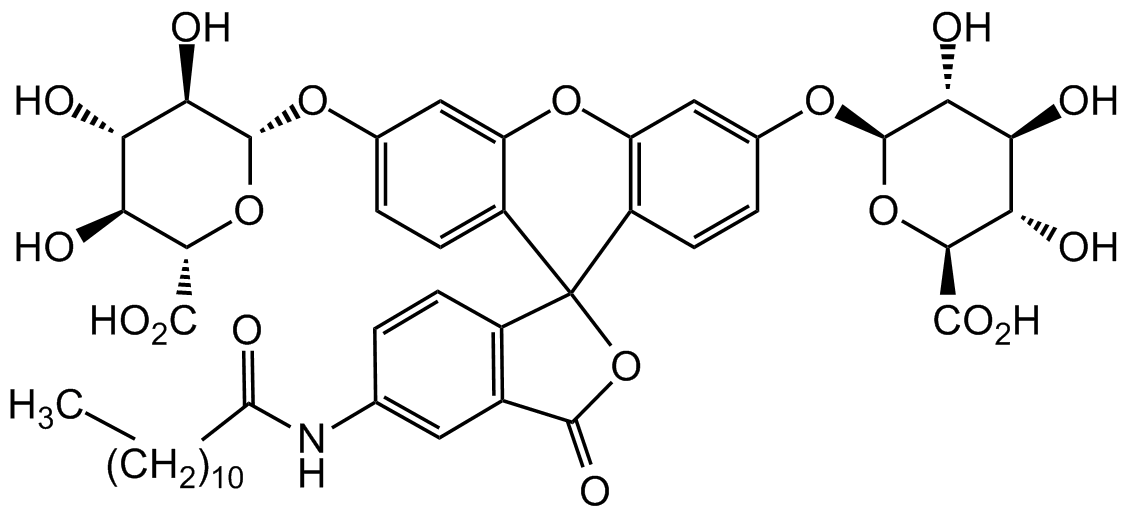
Chemical Structure
5-Dodecanoylaminofluorescein Di-beta-D-glucuronide [423762-14-5]

AG-CY1-0002
Overview
- SupplierAdipoGen Life Sciences
- Product Name5-Dodecanoylaminofluorescein Di-beta-D-glucuronide [423762-14-5]
- Delivery Days Customer10
- CAS Number423762-14-5
- CertificationResearch Use Only
- Estimated Purity>95%
- Molecular FormulaC44H51NO18
- Molecular Weight881.9
- Scientific DescriptionChemical. CAS: 423762-14-5. Formula: C44H51NO18. MW: 881.9. Synthetic. Non-fluorescent reporter protein substrate. This fluorogenic beta-glucuronidase substrate releases the highly fluorescent dye 5-dodecanoylaminofluorescein (Spectral data: lambdaex=490nm, lambdaem=520nm) in direct correlation with enzyme activity. The substrates can penetrate the cell membrane under physiological conditions and forms a non-toxic green fluorescent product that is well retained in viable cells and which allows sorting and cloning of the cells and monitoring of cell development in vitro and in vivo. The colorless and lipophilic substrate enters the cells by embedding in the outer layer of the cell membrane as a glycolipid and then transferring to the inner membrane by a flip-flop mechanism. Once inside the cell, the substrate is cleaved by beta-glucuronidase, generating the green fluorescent enzymatic hydrolysis product 5-dodecanoylaminofluorescein, which is retained in the cell membrane because of its lipophilic hydrocarbon chain, and allowing histochemical, spectrophotometric and fluorometric measurements of GUS gene fusion expression. This substrate has been used in beta-glucuronidase (GUS) gene expression kits. - Non-fluorescent reporter protein substrate. This fluorogenic beta-glucuronidase substrate releases the highly fluorescent dye 5-dodecanoylaminofluorescein (Spectral data: lambdaex=490nm, lambdaem=520nm) in direct correlation with enzyme activity. The substrates can penetrate the cell membrane under physiological conditions and forms a non-toxic green fluorescent product that is well retained in viable cells and which allows sorting and cloning of the cells and monitoring of cell development in vitro and in vivo. The colorless and lipophilic substrate enters the cells by embedding in the outer layer of the cell membrane as a glycolipid and then transferring to the inner membrane by a flip-flop mechanism. Once inside the cell, the substrate is cleaved by beta-glucuronidase, generating the green fluorescent enzymatic hydrolysis product 5-dodecanoylaminofluorescein, which is retained in the cell membrane because of its lipophilic hydrocarbon chain, and allowing histochemical, spectrophotometric and fluorometric measurements of GUS gene fusion expression. This substrate has been used in beta-glucuronidase (GUS) gene expression kits.
- SMILESO=C(O1)C2=C(C=CC(NC(CCCCCCCCCCC)=O)=C2)C31C4=CC=C(O[C@H]5[C@H](O)[C@@H](O)[C@H](O)[C@@H](C(O)=O)O5)C=C4OC6=C3C=CC(O[C@@H]7O[C@H](C(O)=O)[C@@H](O)[C@H](O)[C@H]7O)=C6
- Storage Instruction-20°C,2°C to 8°C
- UNSPSC41116134
References
- Fluorescent staining to visualize GUS transformation in cassava (Manihot esculenta Crantz): S. Laminski, et al.; South Afr. J. Sci 97, 287 (2001)
- VEGF increases engraftment of bone marrow-derived endothelial progenitor cells (EPCs) into vasculature of newborn murine recipients: P.P. Young, et al.; PNAS 99, 11951 (2002)
- Successful allogeneic neonatal bone marrow transplantation devoid of myeloablation requires costimulatory blockade: B.W. Soper, et al.; J. Immunol. 171, 3270 (2003)
- Engraftment of human CD34+ cells leads to widespread distribution of donor-derived cells and correction of tissue pathology in a novel murine xenotransplantation model of lysosomal storage disease: A.A. Hofling, et al.; Blood 101, 2054 (2003)
- beta-Glucuronidase in human intestinal microbiota is necessary for the colonic genotoxicity of the food-borne carcinogen 2-amino-3-methylimidazo[4,5- f ]quinoline in rats: C. Humblot, et al.; Carcinogenesis 28, 2419 (2007)
- Widespread non-hematopoietic tissue distribution by transplanted human progenitor cells with high aldehyde dehydrogenase activity: D.A. Hess, et al.; Stem Cells 26, 611 (2008)
- Gene expression and activity of cartilage degrading glycosidases in human rheumatoid arthritis and osteoarthritis synovial fibroblasts: M. Pasztoi, et al.; Arthr. Res. Ther. 11, R68 (2009)
- Bacillus subtilis spore display of recombinant proteins using a coat-associated enzyme as carrier: S. Potot, et al.; Appl. Environ. Microbiol. 76, 5926 (2010)
- Method for detecting replication or colonization of a biological therapeutic: A.A. Szalay, et al.; WO2013052915A2 (2013)
- Novel interferon-based pre-transplantation conditioning in the treatment of a congenital metabolic disorder: T. Sato, et al.; Blood 121, 3267 (2013)
